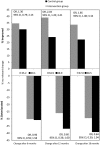Effectiveness of the Assessment of Burden of COPD (ABC) tool on health-related quality of life in patients with COPD: a cluster randomised controlled trial in primary and hospital care
- PMID: 27401361
- PMCID: PMC4947734
- DOI: 10.1136/bmjopen-2016-011519
Effectiveness of the Assessment of Burden of COPD (ABC) tool on health-related quality of life in patients with COPD: a cluster randomised controlled trial in primary and hospital care
Abstract
Objective: Assessing the effectiveness of the Assessment of Burden of COPD (ABC) tool on disease-specific quality of life in patients with chronic obstructive pulmonary disease (COPD) measured with the St. George's Respiratory Questionnaire (SGRQ), compared with usual care.
Methods: A pragmatic cluster randomised controlled trial, in 39 Dutch primary care practices and 17 hospitals, with 357 patients with COPD (postbronchodilator FEV1/FVC ratio <0.7) aged ≥40 years, who could understand and read the Dutch language. Healthcare providers were randomly assigned to the intervention or control group. The intervention group applied the ABC tool, which consists of a short validated questionnaire assessing the experienced burden of COPD, objective COPD parameter (eg, lung function) and a treatment algorithm including a visual display and treatment advice. The control group provided usual care. Researchers were blinded to group allocation during analyses. Primary outcome was the number of patients with a clinically relevant improvement in SGRQ score between baseline and 18-month follow-up. Secondary outcomes were the COPD Assessment Test (CAT) and the Patient Assessment of Chronic Illness Care (PACIC; a measurement of perceived quality of care).
Results: At 18-month follow-up, 34% of the 146 patients from 27 healthcare providers in the intervention group showed a clinically relevant improvement in the SGRQ, compared with 22% of the 148 patients from 29 healthcare providers in the control group (OR 1.85, 95% CI 1.08 to 3.16). No difference was found on the CAT (-0.26 points (scores ranging from 0 to 40); 95% CI -1.52 to 0.99). The PACIC showed a higher improvement in the intervention group (0.32 points (scores ranging from 1 to 5); 95% CI 0.14 to 0.50).
Conclusions: This study showed that use of the ABC tool may increase quality of life and perceived quality of care.
Trial registration number: NTR3788; Results.
Keywords: Chronic Obstructive Pulmonary Disease; Communication tool; Disease Management; Patient-centred care; Quality of Life; Shared Decision Making.
Published by the BMJ Publishing Group Limited. For permission to use (where not already granted under a licence) please go to http://www.bmj.com/company/products-services/rights-and-licensing/
Figures




References
-
- Mannino DM, Homa DM, Akinbami LJ et al. . Chronic obstructive pulmonary disease surveillance—United States, 1971–2000. MMWR Surveill Summ 2002;51:1–16. - PubMed
-
- 2014. From the Global Strategy for Diagnosis, Management and Prevention of COPD, Global Initiative for Chronic Obstructive Lung Disease (GOLD) 2014. Secondary From the Global Strategy for Diagnosis, Management and Prevention of COPD, Global Initiative for Chronic Obstructive Lung Disease (GOLD) http://www.goldcopd.org/
Publication types
MeSH terms
Grants and funding
LinkOut - more resources
Full Text Sources
Other Literature Sources
Medical
Miscellaneous
